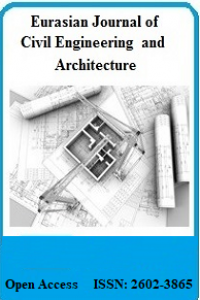Designing Piled Raft Foundations Using Simplified Analysis Methods
Designing Piled Raft Foundations Using Simplified Analysis Methods
There are many factors affecting the load-settlement behavior of the piled raft system. The physical and mechanical properties of the soil, raft foundation and pile foundation have an important effect on this behavior. It is also known that construction stages of buildings also affect this behavior. There are a number of simplified, approximate and advanced
methods for analyzing such a complex system. It is possible to reach the most realistic results in analyzes using advanced finite element methods. However, in order to use
advanced analysis methods, both high-qualified computers are required and analysis times are very long. For this reason, it will be easier for engineers to solve the problem in a
shorter time and with a satisfactory accuracy. In the scope of this study, a piled raft system was analyzed according to different analysis methods such as Terzaghi and Peck
(1967), Tomlinson (2001), Wiesner and Brown (1975), Gok and Togrol (2009), Randolph (1994), Poulos-Davis-Randolph, modifying Poulos-Davis-Randolph and simplified finite
element (Plaxis 2D) methods considering that a raft foundation of 20m by 20m constructed on a silty clay had a base pressure of 200 kPa. In all methods, the load sharing
ratios between the pile group and the raft foundation and the settlement amount of the pile raft system under the structural load were determined. When the pile design is done
according to the pile raft analysis, 64 piles are sufficient as D=0.8m, L=19m and s=2.74m. It has been found that the pile group can carry 75-89% of the total load if the foundation
system is designed as a pile raft system instead of the conventional method. According to the methods used, the settlement values range from 4cm to 14.5cm.
___
- Desai, C. S., Johnson, L. D. & Hargett, C. M. 1974. Analysis of pile supported gravity lock, ASCE Journal of Geotechnical Engineering, 100, 1009-1029.
- Fioravante, V. & Giretti, D. 2010. Contact versus noncontact piled raft foundations, Can. Geotech. J., 47, 1271–1287.
- Gök. S. & Toğrol. E. 2009. Basitleştirilmiş kazıklı radye hesabı, itüdergisi/d mühendislik, 8(5), 149-156.
- Hussein H.H., Karim H.H. & Shlash K.T. 2018. Theoretical verification for full-scale tests of piled raft foundation. In: Abu-Farsakh M., Alshibli K., Puppala A. (eds) Advances in Analysis and Design of Deep Foundations. GeoMEast 2017. Sustainable Civil Infrastructures. Springer, Cham
- Janbu, N. 1976. Static bearing capacity of friction piles. Journal of the Soil Mechanics and Foundations Division, ASCE, 95, SM1.
- Matsumoto, T., Nemoto, H., Mikami, H., Yaegashi, K., Arai, T. & Kitiyodom, P. 2010. Load tests of piled raft models with different pile head connection conditions and their analyses, Soils and Foundations, 50(1):63-81.
- Nguyen, D.D.C., Kim, D. & Jo, S. 2013. Settlement of piled rafts with different pile arrangement schemes via centrifuge tests, Journal of Geotechnical and Geoenvironmental Engineering,139, 1690-1698.
- Poulos, H. G., & Davis, E. H. 1974. Elastics solutions for soil and rock mechanics. New York: John Wiley & Sons
- Poulos, H.G. & Davis, E.H. 1980. Pile foundation analysis and design, John Willey and Sons, New York, USA.
- Poulos, H. G. 2000. Practical design procedures for piled raft foundations. Design applications of raft foundations, 425-468, London: Thomas Telford Ltd.
- Randolph, M. F. 1994. Design methods for pile groups and piled rafts, 13th ICSMFE, New Delhi, India, 61-82.
- Sanctis, L., Russo, G. 2008. Analysis and performance of piled rafts designed using innovative criteria, Journal of Geotechnical and Geoenvironmental Engineering, 134,8, 1118-1128.
- Saran, S. 1996. Analysis and design of substructures, limit state design, Balkema.
- Sawwaf, M. 2010. Experimental study of eccentrically loaded raft with connected and unconnected short piles, Journal of Geotechnical and Geoenvironmental Engineering, 146, 10, 1394-1402.
- Terzaghi, K. & Peck, R.B. 1967. Soil mechanics in engineering practise, John Willey & Sons, NY, 729.
- Tomlinson, M. 2001. Pile design and construction, 7. Press, Prentica Hall.
- Wiesner, T.J. & Brown, P.T. 1975. Behavior of piled strip footings subjected to concentrated loads, Civ. Eng. Res. Rep. R275., Univ of Sydney, Aus.
- Başlangıç: 2017
- Yayıncı: Serkan ŞAHİNKAYA
Sayıdaki Diğer Makaleler
Evaluation of Augmented Reality in Architecture Through Sample Applications
Designing Piled Raft Foundations Using Simplified Analysis Methods
Evaluation of the Green Campus Approach on the Campuses in Turkey
D. DEMİROĞLU, A.e. CENGİZ, A. KARADAĞ
Determination of the Importance of Materials in Structural Cost via Architectural Project Examples
Collaboration in the Ghanaian Construction Industry: Perceived Barriers and Benefits
